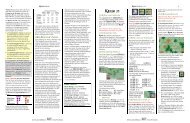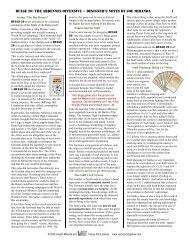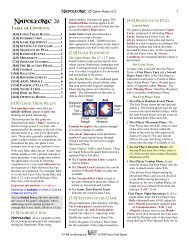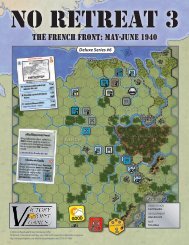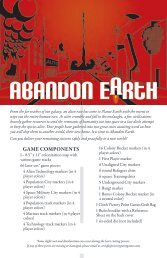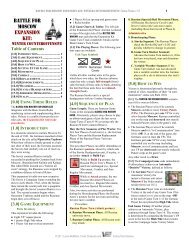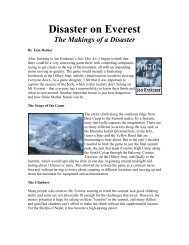Arduous rules - Victory Point Games
Arduous rules - Victory Point Games
Arduous rules - Victory Point Games
You also want an ePaper? Increase the reach of your titles
YUMPU automatically turns print PDFs into web optimized ePapers that Google loves.
The <strong>Arduous</strong> Beginning Game Rules v1.0 4<br />
The German 13th Corps can move southward to<br />
either hex A. Note that it pays 2 Movement<br />
<strong>Point</strong>s to enter the Swamp hex. Also note that<br />
there is no additional cost in Movement <strong>Point</strong>s<br />
to cross the river hexsides, as in some other<br />
wargames. River hexsides only affect combat,<br />
not movement in The <strong>Arduous</strong> Beginning.<br />
The German 13th Corps could also enter either<br />
hex B, but must stop immediately because it<br />
has entered the Enemy Zone of Control (EZOC)<br />
exerted by the Soviet 10th Army (Case 9.1.2).<br />
The German 13th Corps can also move to hex C<br />
and stops because it has used up its entire<br />
Movement Allowance for that Movement Phase.<br />
Note that it used Road Movement (9.3) through<br />
the Forest hexes, paying only 1 Movement <strong>Point</strong><br />
each by moving along the rail line.<br />
In moving to hex D or E, the German 13th Corps<br />
has also spent its entire Movement Allowance<br />
for that turn. Note that hex D is a forest hex, and<br />
therefore costs two Movement <strong>Point</strong>s to enter<br />
(as per the Terrain Effects Chart).<br />
[10.0] COMBAT<br />
General Rule<br />
During each Combat Phase (i.e., Phases 3<br />
and 7), all friendly units may attack<br />
adjacent enemy units. Attacking is<br />
completely voluntary; units are never<br />
compelled to attack.<br />
A “Battle” is an attack on one enemyoccupied<br />
hex by any or all of the attacking<br />
player’s units that are adjacent to that<br />
Battle Hex, the die being cast to determine<br />
its outcome.<br />
Procedure<br />
First, the attacking player (or “attacker;”<br />
i.e., the German Player during the German<br />
Combat Phase, and the Soviet during his<br />
Combat Phase) announces all his Battles –<br />
that is, he declares in advance which enemy<br />
units he will attack and which of his own<br />
(friendly) units will attack them.<br />
• Once Per Combat Phase: A single unit<br />
may only attack once per Combat Phase,<br />
and a single enemy unit may only be<br />
attacked once per Combat Phase.<br />
• Battle Commitment: Once all of a<br />
player’s Battles have been announced for<br />
that Combat Phase, the attacking player<br />
can’t change his mind; no additional<br />
Battles can be announced, nor can previously<br />
announced Battles be cancelled.<br />
The Battle Sequence<br />
Battles are resolved one at a time in any<br />
order the attacking player desires. For each<br />
Battle, the following sequence is followed:<br />
1. Total the Combat Strengths of all the<br />
attacking units in that Battle (taking<br />
Swamp terrain effects into account). If an<br />
untried Soviet Mechanized unit is<br />
attacking, it is flipped over to its revealed<br />
side at this time.<br />
2. Divide this total by the Combat Strength<br />
of the defending unit(s), if an untried<br />
Soviet Mechanized unit is defending, it is<br />
flipped over to its revealed side at this<br />
time, dropping any remainder (or<br />
“fractions”) to get one of the odds levels<br />
provided on the Combat Results Table.<br />
For Example: An attacker’s 16 total Strength<br />
<strong>Point</strong>s engage in a Battle against a defending<br />
unit with a strength of 4 – the odds are 4:1 (four<br />
to one); note that 15 attacking 4 is only 3:1.<br />
3. Determine if the combat effects of<br />
terrain and/or air power have shifted<br />
the odds column.<br />
4. Roll the die and consult the Combat<br />
Results Table; cross-index the row of<br />
the number rolled with the odds column<br />
to determine the result.<br />
5. Apply the combat result immediately.<br />
6. Advance After Combat: If there are no<br />
units remaining in the defending hex<br />
(i.e., they have been eliminated or forced<br />
to retreat), one attacking unit may<br />
immediately move into the defender’s<br />
just-vacated hex.<br />
7. Conduct the next Battle if there are<br />
others that were declared at the beginning<br />
of the Combat Phase yet to be resolved.<br />
When all previously announced Battles are<br />
resolved, that Combat Phase is over.<br />
Cases<br />
[10.1] Revealing Untried Soviet Units:<br />
Soviet Mechanized Corps have<br />
two sides: “untried” and<br />
“revealed.” They begin the game<br />
with their untried side up and<br />
neither player should know the strength of<br />
the unit until it is revealed.<br />
[10.1.1] Revelation Timing: Untried<br />
units are revealed in Step 1 of the Battle<br />
Sequence (when attacking) or Step 2<br />
(when defending).<br />
[10.1.2] 0-Strength Units: A<br />
Soviet Mechanized Corps with<br />
an Attack Strength of zero (0)<br />
can participate in an attack<br />
normally. It contributes no strength to the<br />
attack (obviously), but can still be used to<br />
take required the step loss for an AL<br />
result (10.6) and can Advance After<br />
Combat (10.7).<br />
Soviet Mechanized units had a wide variety<br />
of tank holdings, training levels, and<br />
equipment serviceability. Last-minute<br />
problems with ammunition supplies and<br />
key units away for training meant that even<br />
the Soviet High Command (STAVKA)<br />
could not accurately predict how individual<br />
Corps would perform in combat.<br />
[10.2] Stacking Effects on Combat: All<br />
units in the defending hex must be attacked<br />
together; their combat strength totaled.<br />
Important: Only one unit may attack<br />
through each hexside. That is, while more<br />
than one unit may occupy the same hex,<br />
only one can attack across each hexside.<br />
<br />
<br />
Combat Example: It is the opening German<br />
Combat Phase and, along the north end of the<br />
line, the situation is as illustrated above. The<br />
three Panzer Corps are attacking the Soviet<br />
19th Army (the 8-4), and the two German<br />
Infantry Corps (6th and 13th) cannot participate<br />
because only one unit can attack through each<br />
hexside (indicated by the symbol). The<br />
German 53rd Infantry Corps, however, has<br />
another hexside available to attack through, so<br />
an attack is declared for it against the untried<br />
Soviet Mechanized Corps.<br />
[10.3] Long Odds: After Step 2, above, if<br />
the odds are above 6:1, reduce them to 6:1.<br />
After Step 3, above, if the odds are below<br />
1:1, that attack has no effect on either side.<br />
[10.4] Terrain Effects on Combat: As<br />
shown on the Terrain Effects Chart on the<br />
Player Aid sheet:<br />
• If the defending hex is a Forest, Swamp,<br />
or Fortified hex, reduce the odds by one<br />
column, abbreviated “1” (e.g., a 4:1<br />
attack becomes a 3:1, a 3:1 attack<br />
becomes 2:1, and so on).<br />
• If every attacking unit in a Battle is<br />
across a river from the defending hex,<br />
reduce the odds by one level (1).<br />
• If both the above conditions apply,<br />
reduce the odds by a total of two levels<br />
(2).<br />
• If the defender hex is a Swamp, the<br />
Combat Strengths of all attacking Tank<br />
units (i.e., Panzer and Mechanized) are<br />
© 2009 Frank Chadwick and <strong>Victory</strong> <strong>Point</strong> <strong>Games</strong>



